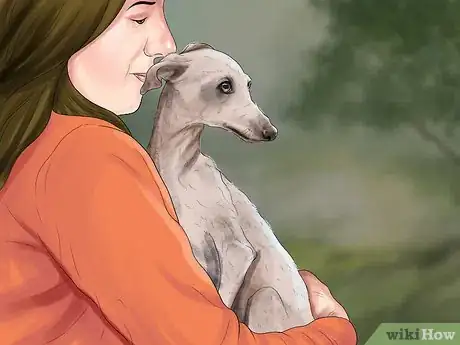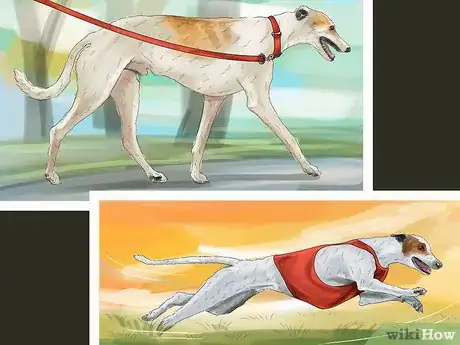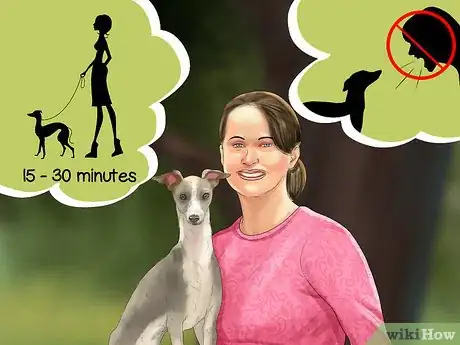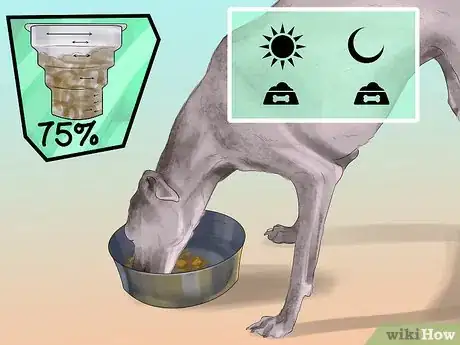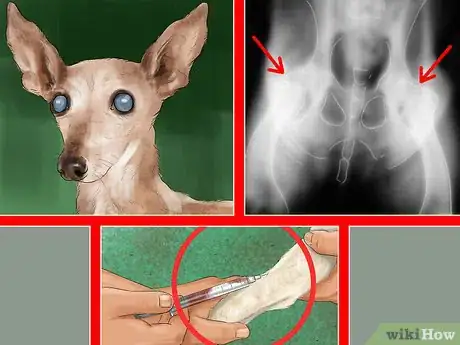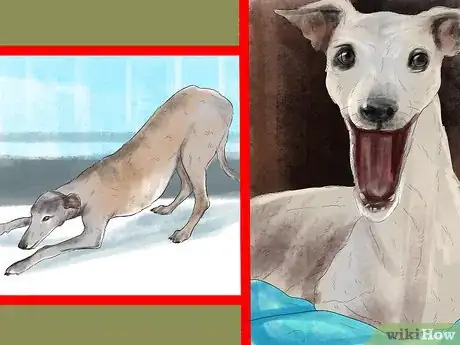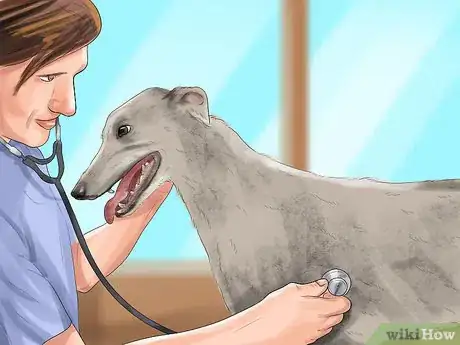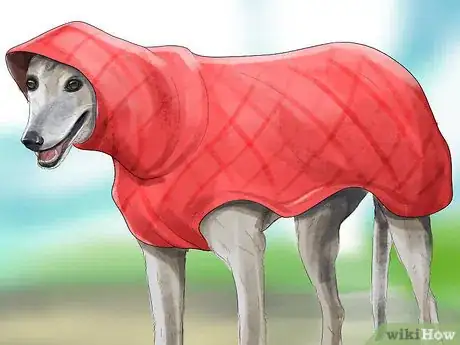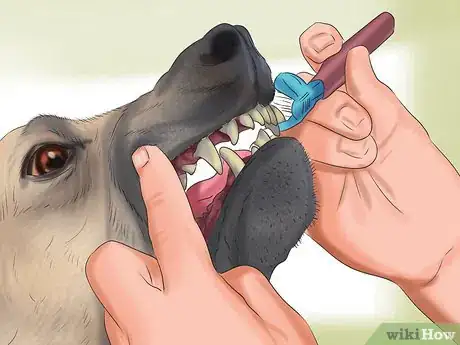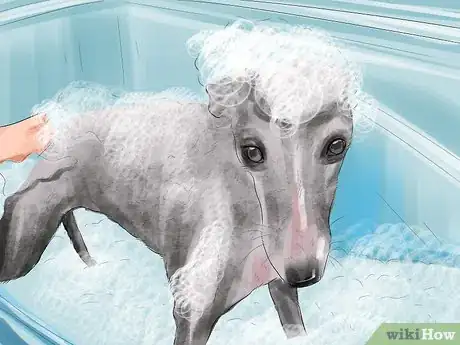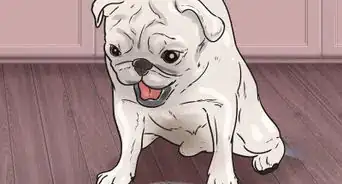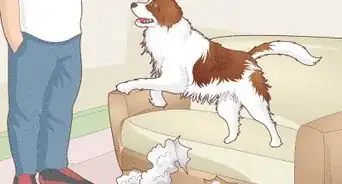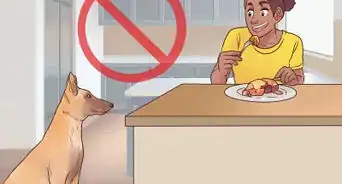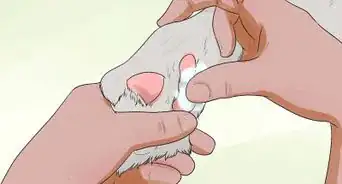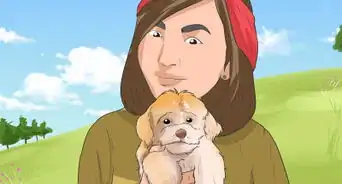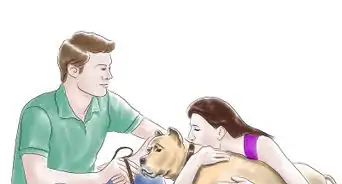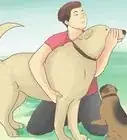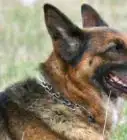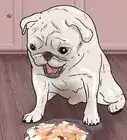This article was co-authored by Melissa Nelson, DVM, PhD. Dr. Nelson is a Veterinarian who specializes in Companion and Large Animal Medicine in Minnesota, where she has over 18 years of experience as a veterinarian in a rural clinic. She received her Doctor of Veterinary Medicine from the University of Minnesota in 1998.
There are 9 references cited in this article, which can be found at the bottom of the page.
wikiHow marks an article as reader-approved once it receives enough positive feedback. In this case, 88% of readers who voted found the article helpful, earning it our reader-approved status.
This article has been viewed 49,721 times.
Italian Greyhounds are gentle, affectionate, and intelligent. While they make excellent lap dogs, they love to sprint and play, and need a moderate amount of exercise. They are companion dogs that love spending time with their owners, so make sure you have time for both snuggling and playing. The right amount of exercise, routine vet visits, and maintaining a healthy diet are all key parts of caring for your Italian Greyhound. While grooming is low maintenance, brushing their teeth and trimming their nails are essential to their care routine as well.
Steps
Balancing Lap Time and Playtime
-
1Spend a lot of time with your dog. Italian Greyhounds are affectionate, gentle, and love to spend most of their time with their owner or family.[1] While they’re sociable and get along well with children and other dogs, they might shy away at first. If you’re thinking about getting an Italian Greyhound, make sure you have plenty of time for both snuggling and activities.[2]
- Do your best not to leave your Italian Greyhound alone for more than a few hours. If you can, stop at home during your lunch break for a quick walk. Spend nights and weekends giving it plenty of affection if you work during the day.
-
2Give your dog the right amount of exercise. Even though they love to nap and sit on laps, Italian Greyhounds are swift and agile, and need a moderate amount of exercise. Go on a couple 15 to 30 minute brisk walks a day.[3]
- Daily running or sprinting helps strengthen their legs and prevent the risk of injury.
- Their size makes them great apartment dogs, and they don't really have any breed-specific space requirements. However, they do benefit from having an enclosed area large enough to sprint and exercise their legs.
- Avoid play with young children or larger dogs and other situations that could cause your dog injury. Be especially careful about your puppy’s playtime, as young Italian Greyhounds are particularly fragile.
Advertisement -
3Give your Italian Greyhound toys. This breed loves to stalk and chase prey, so having balls and fetch toys is a must. Give it chew toys and stuffed animals that it can hunt and chomp on so it doesn't get bored. Making sure it has toys to chew will cut down on any possible damage to your furniture and clothing.[4]
- A bored Italian Greyhound, like many breeds, can get mischievous and chew up your belongings. Make sure it has its own toys to keep it busy.
-
4Train your dog. Since they’re so intelligent, Italian Greyhounds enjoy the mental exercise that comes with training. Start out with basic word commands, such as sit, stay, and come.[5]
- Hold a treat out, say the command, and gently guide your dog into the proper position when just starting to train. Repeat ten or twenty time to make it automatic, and make sure to give a treat and positive encouragement when your dog follows the command.
- Keep training session short and fun, since Italian Greyhounds typically have short attention spans. Always make training rewards-based by using treats and incorporating it into playtime.
- Italian greyhounds are generally sensitive dogs, so it’s important that you never strike, swat at, or yell at them.
-
5Housetrain your Italian Greyhound. While they are intelligent and are trainable, Italian Greyhounds tend to be difficult to housetrain. If you get a puppy, begin housetraining immediately, and get it on a regular food and potty schedule.[6]
- Take your dog out 15 to 30 minutes after eating, and feed your dog at the same times every day. Take it out a few times a day in addition to after eating, including first thing in the morning and a half hour before bed.
- Consider using the crate method. Purchase a crate that allows free movement but isn’t too big. Leave the dog in a crate while at work or at night, letting it out every few hours if possible.
- Don’t scold your dog if you come home to find a mess. If the dog had the accident hours earlier, it won’t make a connection between being scolded and going to the bathroom inside.
- Try leaving pads or paper mats out if you don’t want to use a crate.
- Clean up any accidents promptly with an enzyme cleaner to prevent the dog from being attracted to one particular spot in the home and relieving itself there.
Keeping Your Dog Healthy
-
1Feed your Italian Greyhound twice a day. Two or three smaller meals a day is better for your dog’s digestion than one large meal or leaving food out at all times. Consult your vet about how often and how much food is best for your dog’s age and activity level. Maintaining a healthy diet and weight will help prevent potential problems.
- If you gently press your hands down your dog’s spine and cannot feel its ribs, it might be overweight. Talk to your vet and cut down the amount your dog eats. Cut down on giving your dog treats and other food between meals.
- When buying food for your Italian Greyhound, look for brands marked for toy dog breeds. If you have a puppy, buy food marked specially for puppies.
- Three-fourths to one cup of food twice a day is typically a good amount of food for a small dog.
- Deciding what to feed your dog depends on what's affordable and on your personal preferences. For instance, you might prefer to make raw or homemade dog food or like the ease of store bought brands. Either way, just make sure that you’re feeding your dog balanced, nutritional meals.
- If you want to make your own dog food or put your dog on a raw diet, consult with an animal nutrition expert first. Otherwise, the dog may quickly become unhealthy.
-
2Know the breed’s health risks. While most Italian Greyhounds are healthy, the breed is prone to a few health issues, like hip, thyroid, and eye problems. Knowing if its parents were screened for or had any genetic disorders or breed specific issues will help you keep your dog healthy.[7]
- Ask the breeder or shelter where you got your dog if its parents’ health records are available, preferably prior to purchasing or adopting.
- Many of the health issues Italian Greyhounds are prone to are detected with blood tests that your vet will provide, so regular exams are important.
-
3Look for warning signs of health issues. Get to know your dog's normal behavior. Notice unusual behavior, such as excessively restlessness, pacing, difficulty walking or hesitating to jump, and dry heaving or vomiting. Call your vet if you're concerned about a possible issue.[8]
- Pay special attention to your dog's legs, especially when it's a puppy or juvenile. Note limping or if your dog doesn't put weight on a limb. Italian Greyhounds have fragile bones and are prone to leg fractures.
-
4Take your dog for regular vet exams. Your vet will provide routine screenings for potential inherited disorders, like eye and thyroid problems. They will also make sure your dog is up to date with its vaccinations and check its hips and legs or potential breed-specific concerns.[9]
- Talk to your dog’s vet about its diet and activity level to help your dog maintain a healthy weight. Carrying too much weight will strain an Italian Greyhound’s legs and hips.
- Ask your vet if they recommend flea and tick treatment for your location.
-
5Get it a sweater for cold weather. Keep your Italian Greyhound warm with a coat, jacket, or sweater, especially when going outside during colder months. It should be form fitting, with a curve to match their backline, but should still allow for natural movement.[10]
- Stay away from full sleeves, since they typically restrict movement.
- Knit sweaters tend to fall down the dog’s back and aren’t the most warmest option.
- When shopping for dog attire, look for products that are designed specifically for your breed in order to select the best form and material.
-
6Look for signs of hip problems. Italian Greyhounds are at a higher risk of developing a condition called hip dysplasia. Be on the lookout for symptoms such as limping, hesitation when jumping, and loss of thigh muscle mass. It’s usually inherited, so knowing if either of your dog’s parents had it will help you and your dog’s vet maintain its health.[11]
- Keeping an eye on your dog’s weight, avoiding overfeeding, and giving it regular exercise will help prevent or manage hip dysplasia.
- Consult your vet to decide how much and how often you should feed your dog in order to prevent obesity.
- Be aware dog can develop hip dysplasia at any point in its lifespan, including as a puppy.
Grooming Your Italian Greyhound
-
1Brush your dog’s teeth every day. Since Italian Greyhounds are prone to gum disease and other dental issues, their teeth require daily brushing. Using a small dog toothbrush is preferable to using gauze or a pad wrapped around a finger.[12]
- Your dog might resist brushing, but it’s an essential part of keeping your dog healthy. Be confident and decisive about brushing, but do your best to avoid overwhelming or scaring your dog.
- Your dog will eventually accept brushing as part of its routine if you keep up with it daily.
-
2Trim your dog’s nails. Trimming nails is important, since overgrown nails can cause leg problems in dogs with fragile bones. Clip your Italian Greyhound’s nails every one to two weeks, or when you notice a clicking sound when your dog walks.[13]
- A dog’s nails shouldn’t touch the floor. Check your dog’s gait, or the way it walks, to make sure it doesn’t put too much weight to the backs of its paws due it overgrown nails.
- Using a nail grinder or hand file rather than clippers reduces the risk of removing too much nail, which can cause pain and bleeding.
-
3Keep your dog clean. Italian Greyhounds are fairly low maintenance, aside from tooth and nail care. Use a sink, basin, or tub to bathe your dog as needed, such as if it smells or just got into something messy.
- Keep an eye on its coat for dust or dander, and brush once a week or as needed.
- Check its ears a couple times a week and clean out any wax or debris using gauze wrapped around your finger. Avoid using water to clean out ears.
- Avoid over-bathing you dog, as this can strip the skin of natural oils, which may lead to dry and/or damaged skin.
References
- ↑ http://www.akc.org/dog-breeds/italian-greyhound/care/
- ↑ http://www.vcahospitals.com/main/dog-care/dog-breeds/italian-greyhound
- ↑ http://www.vcahospitals.com/main/dog-care/dog-breeds/italian-greyhound
- ↑ http://www.vcahospitals.com/main/dog-care/dog-breeds/italian-greyhound
- ↑ http://www.vetstreet.com/dogs/italian-greyhound#personality
- ↑ http://www.vcahospitals.com/main/dog-care/dog-breeds/italian-greyhound
- ↑ http://www.caninehealthinfo.org/brdreqs.html?breed=IT
- ↑ http://www.vcahospitals.com/main/dog-care/dog-breeds/italian-greyhound
- ↑ http://www.vetstreet.com/dogs/italian-greyhound#health
About This Article
To care for an Italian greyhound, start by giving it plenty of love and attention, since this breed is very affectionate. Italian greyhounds need a moderate amount of exercise to stay healthy, so try to go on several 15-30 minute brisk walks every day. Because they love to stalk and chase prey, be sure to provide plenty of balls, stuffed animals, and fetch toys. Italian Greyhounds are at a higher risk of developing hip dysplasia, so be on the lookout for symptoms like limping, hesitation when jumping, and loss of thigh muscle mass. They're also prone to dental issues like gum disease, so be sure to brush your dog's teeth once a day! For more grooming tips from our Veterinary co-author, read on!
